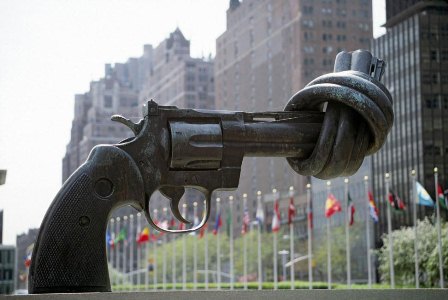General principles
“Resolving to seek a safer world for all and to create the conditions for a world without nuclear weapons, in accordance with the goals of the Treaty on the Non-Proliferation of Nuclear Weapons (NPT), in a way that promotes international stability, and based on the principle of undiminished security for all”
Resolution 1887 1 adopted by the Security Council on 24 September 2009.

The principle of undiminished security for all
Arms control, disarmament and non-proliferation must be rooted in the strategic and security context. As in other spheres, disarmament cannot be ordained : it must be built with patience, perseverance and realism.
In light of the deteriorating strategic environment, nuclear disarmament can only be guided by the principle of undiminished security for all, as the UN resolution 1887 and the 2010 NPT Review Conference have recalled. As stated in the article VI of the NPT states, disarmament is the responsibility of all States, whether or not they possess nuclearweapons
Creating the appropriate conditions for a world without nuclear weapons requires fostering the progress of all in every sphere of disarmament, to reduce the discrepencies between conventional arsenals, to sustain efforts on easing international tensions and improving collective security. A credible nuclear disarmament must go hand in hand with an improvement in the other areas of disarmament (such as biological, chemical and conventional weapons, missile defence, and space).
Collective security can only be built on the basis of mutual trust, itself fed by the willingness to dialogue and cooperate. To progress toward disarmament, it is essential to make multilateralism more effective, to continue our efforts to resolve regional crises and to deepen the strategic dialogue between the main actors.
The principle of strict sufficiency
France applies a principle of strict sufficiency to set the level of its nuclear forces. The French nuclear arsenal has been kept at its lowest level possible compatible with the strategic context. France largely cleared the way : in accordance with its strict sufficiency doctrine it took unilateral actions in order to reduce transparently its arsenal since the end of the Cold War, this is unparalleled among nuclear-weapons States.
Disarmament step by step
The step by step approach to disarmament is the only one able to achieve meaningful and realistic outcomes. This approach was approved in the final document of the 2010 NPT Review Conference, as well as in the UN Security Council Resolution 1887.
The next logical steps are thus the early entry into force of the Comprehensive Test-Ban Treaty (CTBT), the negotiation at the Conference on disarmament of a Fissile Material Cut-Off Treaty (FMCT), further work on the verification of nuclear disarmament, and upholding and pursuing arms control efforts, notably the reduction of the Russian and American nuclear arsenal, which represent more than 90% of the worldwide nuclear weapons stock.
Transparency, as much on doctrine as on arsenals or concrete disarmament efforts, reinforces trust, which is a necessary precondition to the improvement of collective security conditions.
The Negative security assurances
Negative security assurances were given by France to more than one hundred non-nuclear States respecting their non-proliferation obligations. The UN Security Council took note of this declaration, as well as the declaration of other nuclear-weapons States, in UNSC resolution 984 ; it recalled these declarations in UNSC resolutions 1887 (2009) and 2310 (2016).





